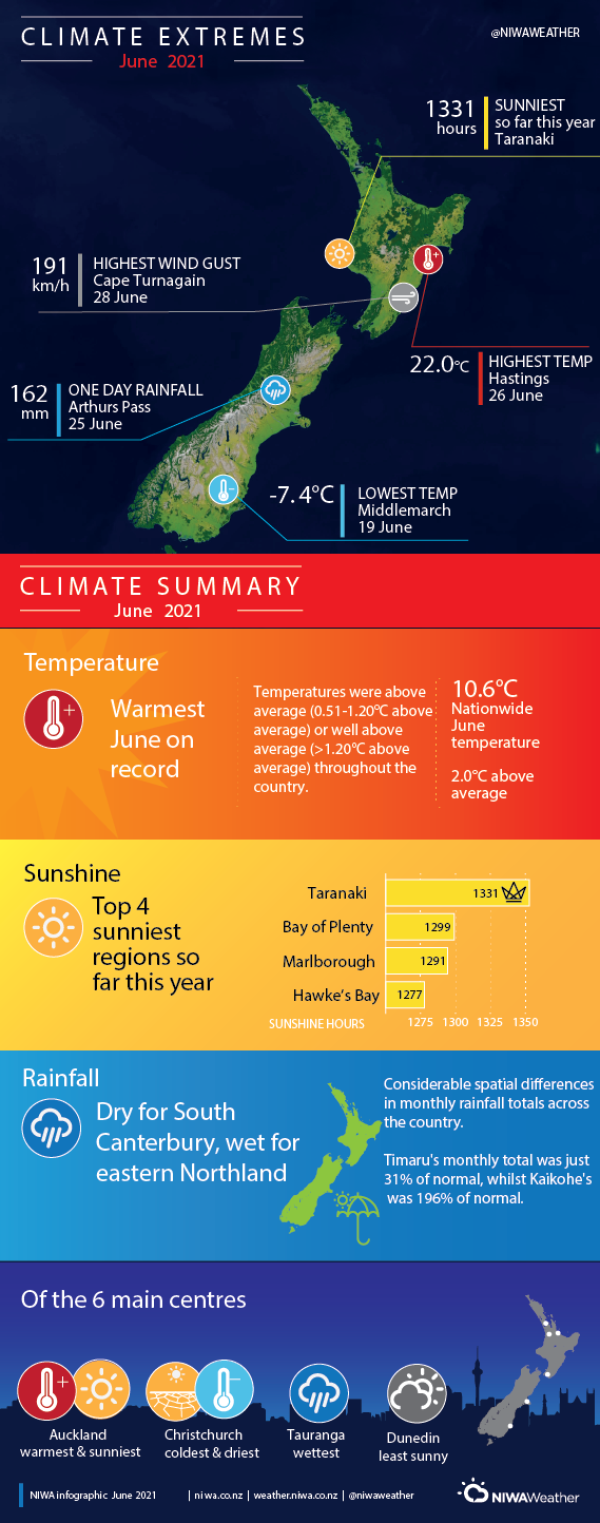New Zealand’s warmest June on record
|
Temperature |
It was New Zealand’s warmest June on record, with the nationwide average temperature 2.0°C above average. This is just the 13th occasion since 1909 that a month achieved an anomaly of >1.9˚C relative to the 1981-2010 average. Temperatures were above average (0.51-1.20°C above average) or well above average (>1.20°C above average) throughout the country. Twenty-four locations observed their warmest June on record. |
|
Rainfall |
Rainfall was above normal (120-149% of normal) or well above normal (>149% of normal) for eastern parts of Northland, inland Bay of Plenty, eastern Waikato, Wairarapa, northern Canterbury, southeastern Otago and western Southland. Rainfall was below normal (50-79% of normal) or well below normal (<50% of normal) for parts of Central Otago, South and Mid Canterbury, Nelson, Tasman, inland Whanganui, Gisborne and eastern Bay of Plenty. |
|
Soil Moisture |
At the end of the month, soil moisture levels were lower than normal for inland parts of Otago. Soil moisture levels were higher than normal for eastern parts of Canterbury and Marlborough. Near normal soil moisture levels were typical for the remainder of the country. |
Overview
June 2021 mean sea level air pressure was above normal to the east of Aotearoa New Zealand. This was associated with more northeasterly air flows than usual over the country. The prevalence of these air flows, occasional low pressure systems that transported warm, humid air down from the sub-tropics, and ongoing background warming from climate change meant it was a very warm start to winter throughout the country. Temperatures were above average (0.51-1.20°C above average) or well above average (>1.20°C above average) throughout New Zealand. Overall, the nationwide average temperature in June 2021 was 10.6°C. This was 2.0°C above the 1981-2010 June average, making it New Zealand’s warmest June since NIWA’s seven station temperature series began in 1909.
There were considerable spatial differences in monthly rainfall totals observed over the country in June. In the North Island, rainfall was above normal (120-149% of normal) or well above normal (>149% of normal) for eastern parts of Northland, inland Bay of Plenty, eastern Waikato, and the Wairarapa. In contrast, rainfall was below normal (50-79% of normal) or well below normal (<50% of normal) for parts of inland Whanganui, Gisborne and eastern Bay of Plenty. For the South Island, rainfall was above normal or well above normal for northern Canterbury, southeastern Otago and western Southland. Rainfall was below normal or well below normal for parts of Central Otago, South and Mid Canterbury, Nelson, and Tasman. Rainfall was typically near normal (80-119% of normal) for remaining areas of New Zealand. By the end of June, soils were drier than normal for inland parts of Otago, and wetter than normal for eastern parts of Canterbury and Marlborough. Soil moisture levels were typically near normal for remaining parts of the country.
Further Highlights:
- The highest temperature was 22.0°C, observed at Hastings on 26 June, and Leigh on 19 June.
- The lowest temperature was -7.4°C, observed at Middlemarch on 19 June.
- The highest 1-day rainfall was 162 mm, recorded at Arthurs Pass on 25 June.
- The highest wind gust was 191 km/h, observed at Cape Turnagain on 28 June.
- Of the six main centres in June 2021, Auckland was the warmest and sunniest, Tauranga was the wettest, Christchurch was the coldest and driest, and Dunedin was the least sunny.
- Of the available, regularly reporting sunshine observation sites, the sunniest four locations in 2021 so far are Taranaki (1331 hours), Bay of Plenty (1299 hours), Marlborough (1291 hours) and Hawke’s Bay (1277 hours).


